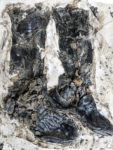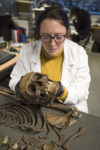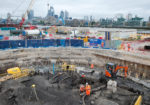 The skeleton of a man wearing high boots have been found lying face-down deep in the mud of the Thames. The remains were unearthed by Museum of London Archaeology (MOLA) Headland Infrastructure archaeologists at the at Tideway’s Chambers Wharf site in Bermondsey, part of a construction project building a new “super sewer” for the city of London. The new Thames Tideway tunnel will be the first major update of London’s sewer system since the Victorian era and the first to conduct the excretions, filth and fatbergs of a city of nine million away from the river that runs through it instead of directly into it.
The skeleton of a man wearing high boots have been found lying face-down deep in the mud of the Thames. The remains were unearthed by Museum of London Archaeology (MOLA) Headland Infrastructure archaeologists at the at Tideway’s Chambers Wharf site in Bermondsey, part of a construction project building a new “super sewer” for the city of London. The new Thames Tideway tunnel will be the first major update of London’s sewer system since the Victorian era and the first to conduct the excretions, filth and fatbergs of a city of nine million away from the river that runs through it instead of directly into it.
 Digging on the Thames foreshore means going through layers of dense waterlogged mud, the kind of medium adept at preserving organic material that would otherwise decay. The soft tissues of the man decomposed, but his leather boots are still going strong. They date to the late 15th or early 16th century. The tops of the boots are folded down to the knees, but would have reached thigh height when pulled all the way up.
Digging on the Thames foreshore means going through layers of dense waterlogged mud, the kind of medium adept at preserving organic material that would otherwise decay. The soft tissues of the man decomposed, but his leather boots are still going strong. They date to the late 15th or early 16th century. The tops of the boots are folded down to the knees, but would have reached thigh height when pulled all the way up.
They aren’t the sexy pirate thigh-highs. These were practical garments, not fashion statements. Made of leather quarters stitched together with flax thread, the boots had no heels and the one flat sole was strengthened with “clump soles,” at the front and back. They were also stuffed with a plant material that hasn’t been identified yet (perhaps moss) to insulate and customize the fit.
 So much leather was expensive and was often reused. That kind of investment clothing wasn’t likely to be deliberately included in a burial. The position of the body — face-down, with one arm above his head with the other bent back on itself to the side — suggests an accidental death. Osteological examination found no evidence of perimortem injuries or any cause of death. His bones did reveal that while he was a young man by our standards, less than 35 years old, he had worked hard during his short life.
So much leather was expensive and was often reused. That kind of investment clothing wasn’t likely to be deliberately included in a burial. The position of the body — face-down, with one arm above his head with the other bent back on itself to the side — suggests an accidental death. Osteological examination found no evidence of perimortem injuries or any cause of death. His bones did reveal that while he was a young man by our standards, less than 35 years old, he had worked hard during his short life.
“We know he was very powerfully built,” says Niamh Carty, an osteologist, or skeletal specialist, at MOLA. “The muscle attachments on his chest and shoulders are very noticeable. The muscles were built by doing a lot of heavy, repetitive work over a long period of time.”
It was work that took a physical toll. Although only in his early thirties, the booted man suffered from osteoarthritis, and vertebrae in his back had already begun to fuse as the result of years of bending and lifting. Injuries to his left hip suggest he walked with a limp, and his nose had been broken at least once. There’s eviden[ce] of blunt force trauma on his forehead that had healed before he died.
“He didn’t have an easy life,” says Carty. “Early thirties was middle age back then, but even so, his biological age was older.”
 He also had deep grooves in his teeth caused by repeatedly holding something or pulling something over the biting surface of the teeth. Fishermen and sailors were known to have passed rope between their teeth. If he had a river-based job like fishing, sailing, dock work or mudlarking, that would explain the boots. They would have been waders, an important tool very much worth the expense for a worker who had to wade in the deep, sticky muck of the Thames day in and day out.
He also had deep grooves in his teeth caused by repeatedly holding something or pulling something over the biting surface of the teeth. Fishermen and sailors were known to have passed rope between their teeth. If he had a river-based job like fishing, sailing, dock work or mudlarking, that would explain the boots. They would have been waders, an important tool very much worth the expense for a worker who had to wade in the deep, sticky muck of the Thames day in and day out.
That is really interesting information. It is absolutely amazing how much information can be gleaned by scientific means from remains that are hundred of years old. :yes:
Wow, crazy what we can deduce now from stuff like this.
One doesn’t write “the city of London” when one means London, lest the former be confused with the City of London.
One must also distinguish the City of London – a geographical and political unit aka “the square mile” – from “the City” – a metaphor for the totality of London financial businesses. (Except perhaps Hedge Funds, whose lair is often elsewhere.)
Let it be so.
Would you point me to a link that further explains the difference in City of London and The City of London? They look exactly the same here.